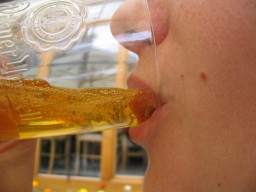Alcohol labelling and the social norm
Posted on Friday, August 15 2014

By Dr John McAlaney, Lecturer in Psychology and Chartered Psychologist.
The All-Party Parliamentary Group on Alcohol Misuse recently proposed that the packaging and bottles of alcoholic beverages should include health warnings, in order to reduce the health-related and economic harms caused by alcohol misuse in the UK. Such an approach has of course been used for many years across the world for the sale of cigarettes and other tobacco products. The rationale behind this is that educating individuals on the risks of certain behaviours will enable them to make more informed decisions. Whilst this may be beneficial in some situations the long-term efficacy of alcohol education has been questioned, with an increasing movement away from using ‘health terrorism’ techniques which use negative and extreme imagery to dissuade people from misusing alcohol.
When considering how to address the issues associated with alcohol use it is important to take into account social psychological factors. Drinking alcohol is for many people done in a social situation. It is actively encouraged in many situations such as on nights out or at parties. Indeed it could be argued that drinking alcohol in some settings is seen to be the default option, and that anyone who chooses not to do so must often give a solid justification as to why they are not drinking, such as being a designated driver or for religious reasons. In addition there are a myriad of cultural factors associated with alcohol use. For example heavy drinking in young adults in the UK, and particularly amongst students, can be seen as a natural part of the transition into adulthood.
At the same time excessive alcohol use is condemned. The media often focuses on binge drinking and the harm that this can cause to individuals and societies. TV programmes feature footage of drunken behaviour in city centres on the weekend and highlight the burden that this can place on the police and A&E departments. However, characterising what ‘excessive’ alcohol use is can be problematic. Definitions vary internationally, and even within the UK. Many definitions do not take into account factors such as the period of time over which the alcohol is consumed, or the metabolism and body weight of the individual. Overall, alcohol holds a unique and contradictory status in the UK in being socially approved yet in many ways publically condemned.
Just how accurate are we in our perceptions of the alcohol use of others? Research would suggest that we tend to overestimate how much other people drink and how acceptable they think excessive alcohol use is. This effect appears to be especially pronounced in young adults. There are a number of possible reasons why we might tend to hold these misperceptions. Psychological processes such as memory and attention biases mean that we are more likely to notice and remember the one person in a bar who is drunk and loud than the many that are sober and quieter. Social media platforms such as Facebook and Twitter also allow for the rapid dissemination of stories and pictures relating to alcohol consumption, which might further add to our perception that people around us drink alcohol more frequently and heavily than is actually the case. Even campaigns which aim to reduce alcohol consumption might inadvertently contribute to misperceptions. These campaigns often involve imagery of the target population drinking alcohol, which could suggest that this behaviour is a norm.
This work has led to the development of a new form of intervention and prevention, known as the social norms approach. This technique operates on a simple premise – if people tend to overestimate how heavily their peers drink alcohol then challenging these misperceptions should reduce the social pressure on the individual to drink heavily themselves. This, in turn, means their own consumption should decrease. This can be done in a variety of ways such as mass media campaigns or personalised online feedback. This approach is increasingly popular in Europe (see www.europeansocialnormsinstitute.wordpress.com for further information) and in contrast to more traditional approaches does not utilise negative imagery or moralistic messages on how people ‘should’ behave. In the words of former Minister for Scottish Parliament, Dr Bill Wilson,
“I am convinced that it is a relatively simple and cost-effective means of achieving behavioural change. Most importantly, it is positive rather than negative. It does not condemn, preach or use scare tactics, and it works!”
Alcohol labelling could be used to support this approach. Environmental cues can help determine norms, so as in the case of tobacco including health warnings on packaging may help create a norm that excessive alcohol use is not something that is desirable. However, caution must be taken to ensure that the health warnings used do not promote the message that the majority of people are using alcohol irresponsibly on a frequent basis. It is worth noting that based on national surveys and government definitions the majority of even the heaviest drinking group in the UK, namely young men, do not regularly binge drink.
Alcohol labelling and health warnings may be useful in enabling people to make more informed decisions about alcohol, but this must be done in a way that reflects the context of alcohol use in the UK. In short, we must cut through the hype and misconceptions around alcohol use if long-term culture change is to be achieved.
 Bournemouth University
Bournemouth University